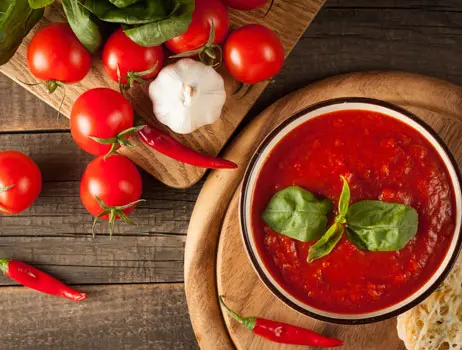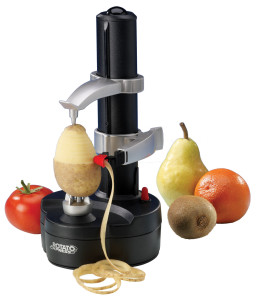
Tips for a Perfect Tomato Sauce
Probably one of the most commonly cooked sauces (if not the most) is the tomato sauce. It is easy to make, versatile and has a very accessible flavor. What’s more is everyone has their own version: be it your neighbor’s version or your grandmother’s recipe passed down generations, there is a wide array of “best” tomato sauces out there. However, there are many ingredients and techniques you can bring to your sauce to pair it up with the greats.
When making a sauce, fresh tomatoes are always better, especially locally grown, in-season ones. To peel them, simply use the Starfrit Rotato Express peeler. It instantly peels whole tomatoes with the push of a button making them much easier to mash afterwards. If you can’t get your hands on fresh tomatoes, canned will do the trick.

 For fattening, butter (as always) yields the best taste but may become a bit much for an entire plate of spaghetti. A buttered sauce would be more fitting for, say, a few raviolis. The best choice for all-around fattening remains olive oil because of its flavor fusion properties and melt-in-your-mouth feel.
Because tomatoes are naturally acidic, any good tomato sauce prepping requires a counterbalancing of flavors. For example, browning onions and a couple cloves of garlic in an oiled saucepan before the tomatoes is an effective way to offset the acidity. Sugar also helps a great deal in this regard when added during the simmering process. Before adding your tomatoes, make sure to reduce some red wine as well. While eliminating the alcohol, this will make your sauce more robust and rich. White wine on the other hand can be used for added fruitiness.
As your sauce simmers, remember to keep the lid off as much as possible. Keeping the lid on will steam the sauce, taking away its richness and firmness.
To help bring out the flavor of each ingredient, you can add a pinch of salt every time you put in new foods: adding meat? A pinch of salt. Veggies? Pinch of salt. Although this may seem like excess sodium, a lot of the salt gets dissolved the longer your sauce simmers. While it is a polarizing ingredient, anchovies can add a nice salty, umami taste to your sauce very efficiently and without any fishy taste, despite widespread belief. One or two filets ought to do it!
As for herbs, there are many different combinations possible that will all give great tasting sauces. Parsley, oregano, rosemary and thyme are recurring characters in this play as well as many others but the one constant in all sauces should be basil – fresh basil to be precise. ¬It is without a doubt the herb of choice because it effectively infuses its flavor to the sauce more loosely than most herbs.
For fattening, butter (as always) yields the best taste but may become a bit much for an entire plate of spaghetti. A buttered sauce would be more fitting for, say, a few raviolis. The best choice for all-around fattening remains olive oil because of its flavor fusion properties and melt-in-your-mouth feel.
Because tomatoes are naturally acidic, any good tomato sauce prepping requires a counterbalancing of flavors. For example, browning onions and a couple cloves of garlic in an oiled saucepan before the tomatoes is an effective way to offset the acidity. Sugar also helps a great deal in this regard when added during the simmering process. Before adding your tomatoes, make sure to reduce some red wine as well. While eliminating the alcohol, this will make your sauce more robust and rich. White wine on the other hand can be used for added fruitiness.
As your sauce simmers, remember to keep the lid off as much as possible. Keeping the lid on will steam the sauce, taking away its richness and firmness.
To help bring out the flavor of each ingredient, you can add a pinch of salt every time you put in new foods: adding meat? A pinch of salt. Veggies? Pinch of salt. Although this may seem like excess sodium, a lot of the salt gets dissolved the longer your sauce simmers. While it is a polarizing ingredient, anchovies can add a nice salty, umami taste to your sauce very efficiently and without any fishy taste, despite widespread belief. One or two filets ought to do it!
As for herbs, there are many different combinations possible that will all give great tasting sauces. Parsley, oregano, rosemary and thyme are recurring characters in this play as well as many others but the one constant in all sauces should be basil – fresh basil to be precise. ¬It is without a doubt the herb of choice because it effectively infuses its flavor to the sauce more loosely than most herbs.


 For fattening, butter (as always) yields the best taste but may become a bit much for an entire plate of spaghetti. A buttered sauce would be more fitting for, say, a few raviolis. The best choice for all-around fattening remains olive oil because of its flavor fusion properties and melt-in-your-mouth feel.
Because tomatoes are naturally acidic, any good tomato sauce prepping requires a counterbalancing of flavors. For example, browning onions and a couple cloves of garlic in an oiled saucepan before the tomatoes is an effective way to offset the acidity. Sugar also helps a great deal in this regard when added during the simmering process. Before adding your tomatoes, make sure to reduce some red wine as well. While eliminating the alcohol, this will make your sauce more robust and rich. White wine on the other hand can be used for added fruitiness.
As your sauce simmers, remember to keep the lid off as much as possible. Keeping the lid on will steam the sauce, taking away its richness and firmness.
To help bring out the flavor of each ingredient, you can add a pinch of salt every time you put in new foods: adding meat? A pinch of salt. Veggies? Pinch of salt. Although this may seem like excess sodium, a lot of the salt gets dissolved the longer your sauce simmers. While it is a polarizing ingredient, anchovies can add a nice salty, umami taste to your sauce very efficiently and without any fishy taste, despite widespread belief. One or two filets ought to do it!
As for herbs, there are many different combinations possible that will all give great tasting sauces. Parsley, oregano, rosemary and thyme are recurring characters in this play as well as many others but the one constant in all sauces should be basil – fresh basil to be precise. ¬It is without a doubt the herb of choice because it effectively infuses its flavor to the sauce more loosely than most herbs.
For fattening, butter (as always) yields the best taste but may become a bit much for an entire plate of spaghetti. A buttered sauce would be more fitting for, say, a few raviolis. The best choice for all-around fattening remains olive oil because of its flavor fusion properties and melt-in-your-mouth feel.
Because tomatoes are naturally acidic, any good tomato sauce prepping requires a counterbalancing of flavors. For example, browning onions and a couple cloves of garlic in an oiled saucepan before the tomatoes is an effective way to offset the acidity. Sugar also helps a great deal in this regard when added during the simmering process. Before adding your tomatoes, make sure to reduce some red wine as well. While eliminating the alcohol, this will make your sauce more robust and rich. White wine on the other hand can be used for added fruitiness.
As your sauce simmers, remember to keep the lid off as much as possible. Keeping the lid on will steam the sauce, taking away its richness and firmness.
To help bring out the flavor of each ingredient, you can add a pinch of salt every time you put in new foods: adding meat? A pinch of salt. Veggies? Pinch of salt. Although this may seem like excess sodium, a lot of the salt gets dissolved the longer your sauce simmers. While it is a polarizing ingredient, anchovies can add a nice salty, umami taste to your sauce very efficiently and without any fishy taste, despite widespread belief. One or two filets ought to do it!
As for herbs, there are many different combinations possible that will all give great tasting sauces. Parsley, oregano, rosemary and thyme are recurring characters in this play as well as many others but the one constant in all sauces should be basil – fresh basil to be precise. ¬It is without a doubt the herb of choice because it effectively infuses its flavor to the sauce more loosely than most herbs.

